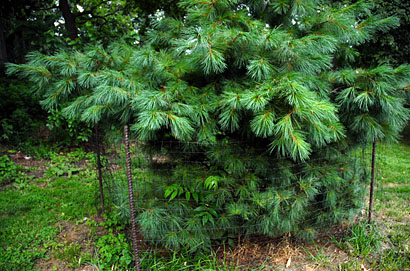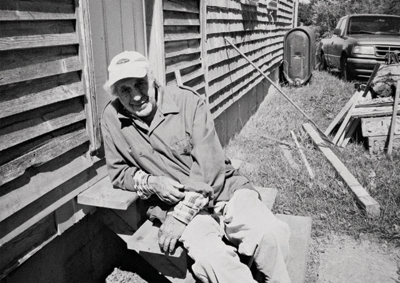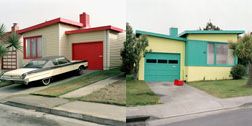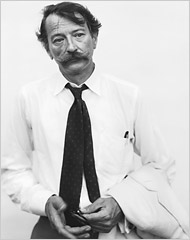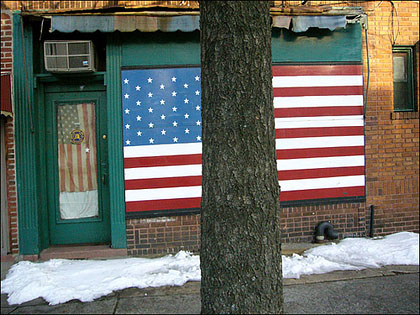 "The Americans," Robert Frank, sixth printing, 1997
"The Americans," Robert Frank, sixth printing, 1997When bloggers refer to
Robert Frank, they usually mean his still pictures from around the time of
The Americans, one of the most important photo books of the last century. Given the ubiquity of Frank's influence, it's a shock to remember that it was first published nearly 50 years ago.
I first saw
The Americans when it was republished in 1969. I wasn't a photographer yet, but
its pictures were a revelation to me. They were dark & ferocious. They broke all the rules. There was a sense of the consuming strangeness of being an outsider looking into scenes whose participants saw nothing at all strange. I had never felt this kind of excitement -- mixed with discomfort & even fear -- in photographs before. I wondered what made them so different. They were completely unlike the pictures I had previously admired, which were perfectly composed & intended to mean only one thing. In those pictures the photographers had seemed to be in complete control. But Frank had let go of that. He had volunteered for the vulnerability of being a stranger. As a triple outsider (Swiss, a Jew, a New Yorker in the outlands), Frank had allowed the world to wash over fresh eyes and mean what it means, not what he -- or we or anyone -- decided it should mean.
Surprise, it didn't mean only one thing anymore. Welcome to the sixties.
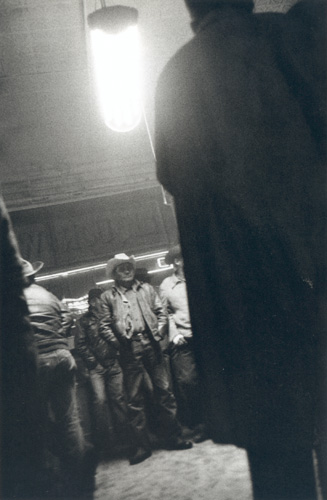 "Gallup, New Mexico," Robert Frank, All rights reserved
"Gallup, New Mexico," Robert Frank, All rights reserved
I have always carried in my head one picture from
The Americans of a bar in Gallup, New Mexico. Tilted, blurry, glimpsed between indistinct silhouettes, dominated by a glaring overhead bulb, it shows rough men in jeans & cowboy hats standing at a bar. It's a spy shot really, taken warily, possibly a hip shot. The awkward angle & unheard-of tilt emphasize the photographer's urgency. The picture has a drunken, transgressive quality.The ugly room & grainy print let us know we're in the lower depths. Yet the composition recalls a high-noon showdown, a classic & ultimately noble shootout between a good cowboy & a bad cowboy. Except the man facing the camera is an Indian.
Here's a true story: In 1970 I passed through Gallup on my way to the West Coast. A major Native American pow-wow was underway -- dances, a rodeo, trading, sports & socializing. Indians from many tribes were there, along with a few white tourists from a nearby RV camp. At night the main street, which was one long lineup of bars as I remember it, was full of Indian men. The tourists were nowhere to be seen. The Indians were drinking hard. Outside the bars, cops waited in parked cars -- a surprising variety of cruisers & uniforms -- I supposed they were tribal police in addition to local, county & state. I drank a couple of beers in the bars, but I was acutely self-conscious. The drunkeness was frightening. In the hour or so I was there I saw two fights break out. I retreated to my car & campsite.
 Notice on Yancey Richardson Gallery website, 7/2007
Notice on Yancey Richardson Gallery website, 7/2007To my mind
The Americans is a work of contrarian genius. But the contrariness doesn't end there. After he made the book, Frank turned primarily to making movies. When the book finally began to receive critical acclaim in the U.S., he left New York City & moved to a gloomy exile in rural Nova Scotia. To many at the time, his actions seemed inexplicable if not self-destructive. But, unlike his contemporary, J.D. Salinger, who became a recluse in New Hampshire after his novel
Catcher in the Rye became a national sensation, Frank continued to turn out work, both movies and stills. Like another contemporary, Bob Dylan, Frank had no intention of repeating what his fans wanted for the rest of his life.
 "Andrea, Mabou, 1977 (with ship), " Robert Frank, All rights reserved
"Andrea, Mabou, 1977 (with ship), " Robert Frank, All rights reservedFrank's later photographs are very different from those in
The Americans. Still black and white, with a taste for underexposure, using large format, polaroids, cinema film, employing narrative, scratched negatives, scrawled & typed words, populated with signposts, land & sea scapes, wild skies and very few people, these pictures seem composed in a dark runic language. The ones I have seen are beautiful, but I don't understand the language. I don't have the key.
My guess is that meaning is no longer the point. The Americans went a long way toward shattering complacent ideas about public meaning. The more recent works seem to say the only meaning is personal -- & even that may be impossible.
